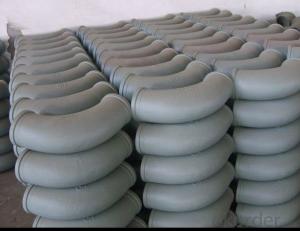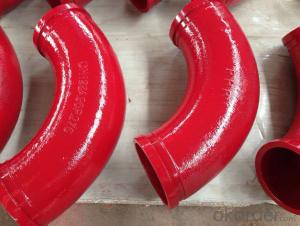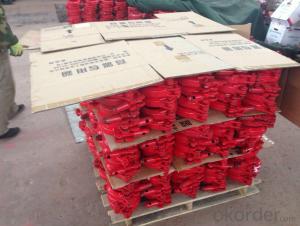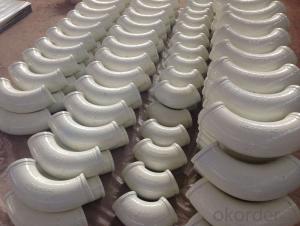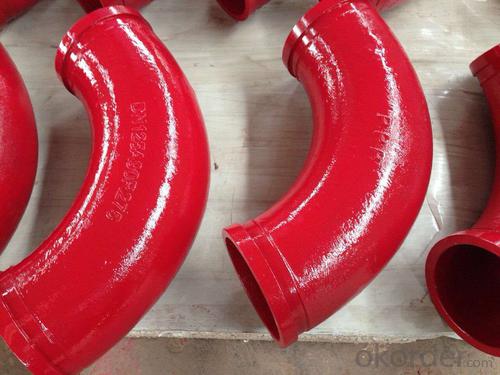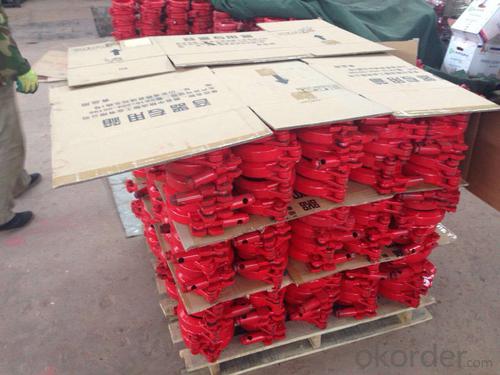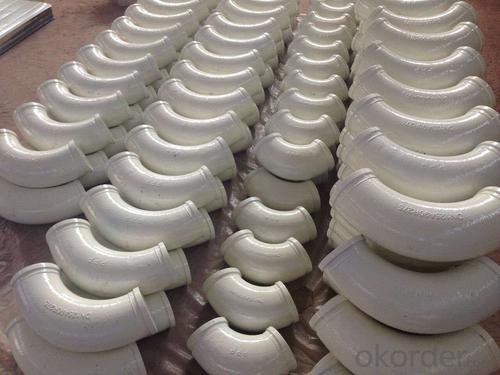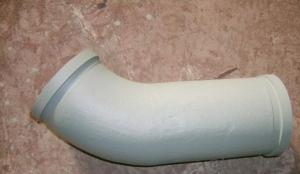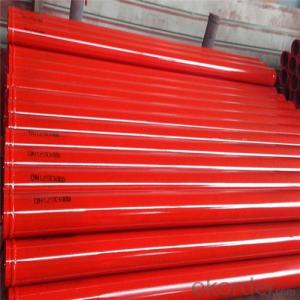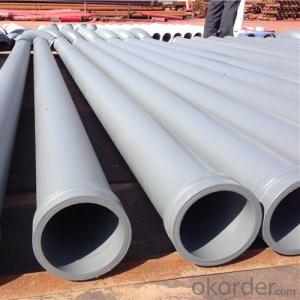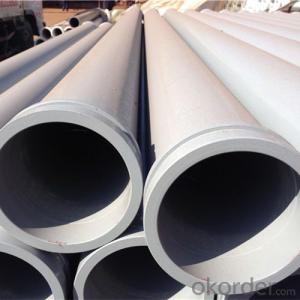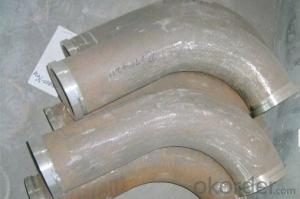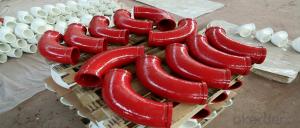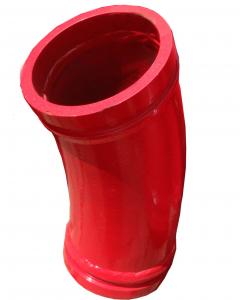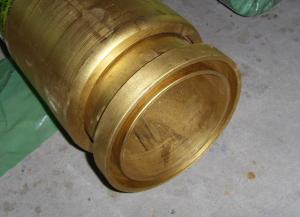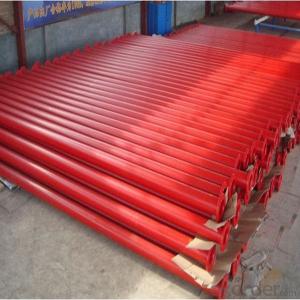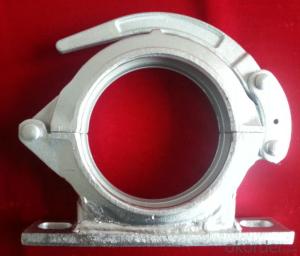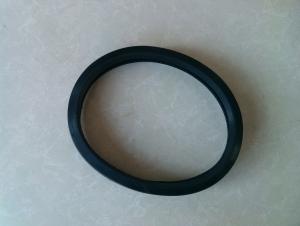CONCRETE DELIVERY ELBOW PM TYPE 90DEG R275 DN125 FLANGE 157MM
- Loading Port:
- Tianjin
- Payment Terms:
- TT OR LC
- Min Order Qty:
- 100 pc
- Supply Capability:
- 10000 pc/month
OKorder Service Pledge
OKorder Financial Service
You Might Also Like
concrete pump elbow table
Wear-resistant Single or Double Concrete Pump Elbow | |||||||
Type | Singe Elbow | Double Elbow | |||||
Model | DN125 | DN150 | DN175 | DN125 | |||
Material | Casting Steel ,ST52 | Inside | 40Cr | Outside | |||
Size | R275*90° | R275*90°+110 | 36° | F2000 | R275*90° | R275*90°+110 | |
R275*45° | R275*90°+211 | R400*30° | A3000 | R275*45° | R275*90°+211 | ||
R275*25° | R275*90°+411 | R400*45° | 471B | R275*25° | R275*90°+411 | ||
R275*20° | R275*90°+424 | R400*30° | 571B | R275*20° | R275*90°+424 | ||
R275*15° | R275*45°+170 | R488*90° | A1000 | R275*15° | R275*45°+170 | ||
R180*90° | R275*45°+310 | R500*90 | C1000 | R180*90° | R275*45°+310 | ||
R232*60° | R275*45°+310 | R280*90° | B2000 | R232*60° | R275*45°+310 | ||
R240*36° | 20°Lengthen | R240*36° | 20°Lengthen | ||||
R240*30° | 25°+740 | R240*30° | 25°+740 | ||||
R240*15° | 40°Zoomlion | R240*15° | 40°Zoomlion | ||||
R385*29° | R385*29° | ||||||
R315*33° | R315*33° | ||||||
Technic | Forged | ||||||
Average life | 25,000cubic | 50,000cubic | |||||
Appliciation | Used in concrete transport in construction work | ||||||
1.product profile:The double layer concrete pump elbow is developed by ourselves through new
technology and process.
2.characteristic:the inner layer of this concrete pump elbow undergoes heat treatment,and then the rigitiry can reach 62-65HRC.
3.characteristic:the outer layer of the concrete pump elbow possess good toughness properties
to protect the inner layer,so the security of the elbow is improved.
4.life:the experiment done abroad shows that the life of our concrete pump elbow can reach 35000-50000cbm,got the customers' praise
5.Beside the double layer concrete pump elbow,we produce all kinds of concrete pump parts,
straight pipe hose flange coupling and so on.
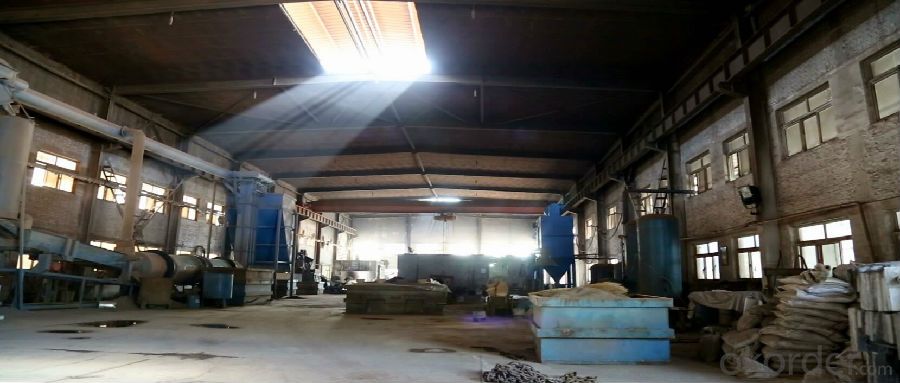
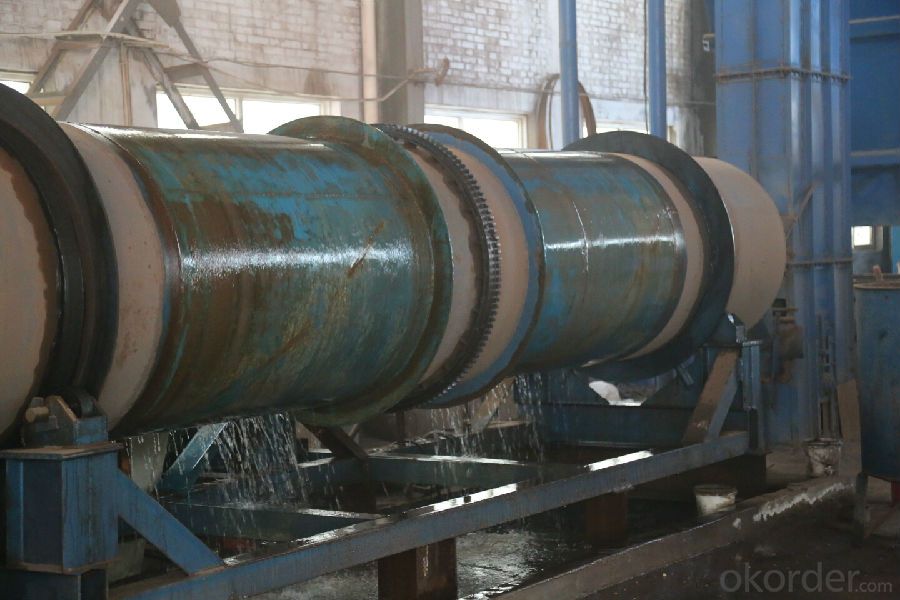
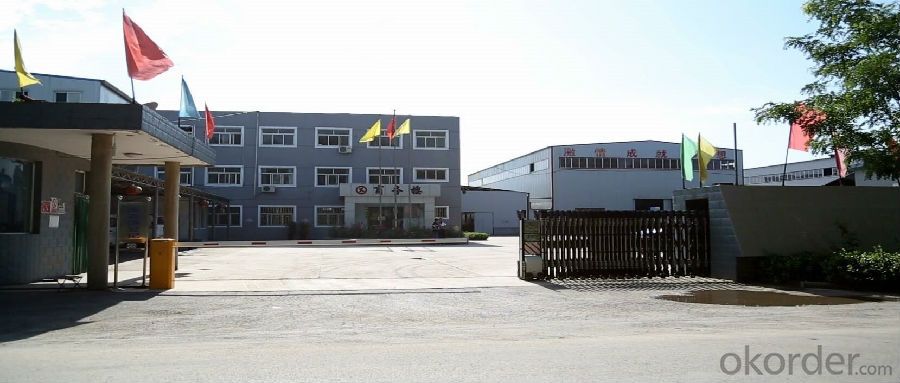
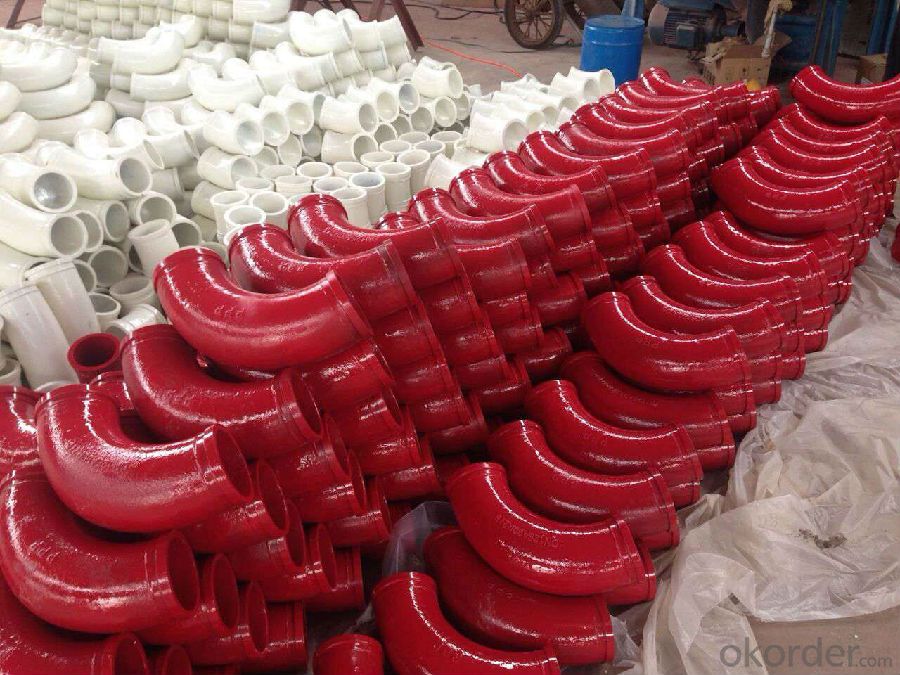
- Q: Are there any specific guidelines for the installation of wear plates or wear rings in concrete pump spare parts?
- Concrete pump spare parts, such as wear plates or wear rings, have specific guidelines for their installation. These guidelines guarantee proper installation and optimal equipment performance. Here are some essential guidelines to consider: 1. Prior to installation, thoroughly examine the wear plates or wear rings for any damage or defects. Replace any damaged or worn-out parts to ensure efficient operation. 2. Ensure that the concrete pump and all related components are clean and clear of debris or contaminants. Doing so will prevent premature wear and prolong the lifespan of the wear plates or wear rings. 3. Before installation, apply a suitable lubricant to the wear plates or wear rings. This will minimize friction and extend the components' service life. 4. Proper alignment is crucial for the effective functioning of wear plates or wear rings. Make sure the plates or rings are correctly aligned and securely fixed in place. Misalignment can cause premature wear and equipment damage. 5. Use the recommended torque specifications to tighten the bolts or fasteners that secure the wear plates or wear rings. Improper tightening can result in equipment malfunction or damage. 6. Implement a regular maintenance schedule to inspect and replace worn-out wear plates or wear rings. Regular maintenance will help detect and address any issues before they lead to major breakdowns or costly repairs. It is important to consult the manufacturer's guidelines and adhere to their specific instructions for the installation of wear plates or wear rings in concrete pump spare parts. Following these guidelines will ensure the equipment's optimal performance and longevity.
- Q: How often should hopper cylinders be inspected or replaced in a concrete pump?
- Hopper cylinders in a concrete pump should be inspected regularly to ensure optimal performance and prevent potential malfunctions. The frequency of inspections and replacements depends on several factors, including the intensity of usage, the type of concrete being pumped, and the overall condition of the equipment. As a general guideline, it is recommended to inspect hopper cylinders at least on a monthly basis or after every 100 hours of operation, whichever comes first. During these inspections, the cylinders should be thoroughly examined for any signs of wear, corrosion, or damage. Additionally, the seals, gaskets, and other components connected to the cylinders should be checked for proper functioning. However, it is important to note that the inspection frequency may need to be increased if the concrete being pumped contains abrasive materials or if the pump is being used in harsh environmental conditions. In such cases, more frequent inspections and replacements may be necessary to avoid unexpected breakdowns and costly repairs. Ultimately, the goal is to maintain the hopper cylinders in good condition and address any issues promptly. Regular inspections, along with routine maintenance and proper cleaning, can significantly prolong the lifespan of the cylinders and ensure the concrete pump operates efficiently and safely.
- Q: What are the most commonly replaced spare parts for concrete pumps?
- The most commonly replaced spare parts for concrete pumps are typically wear parts such as concrete delivery pipes, rubber hoses, and wear plates. Other commonly replaced parts include seals, gaskets, pistons, and hydraulic components.
- Q: Can concrete pump spare parts be painted or coated for increased durability?
- Yes, concrete pump spare parts can be painted or coated for increased durability. Painting or coating the spare parts can help protect them from corrosion, wear, and other forms of damage. By applying a layer of paint or coating, the spare parts can have improved resistance to harsh environmental conditions, chemicals, and moisture. Additionally, certain paints or coatings can offer additional benefits such as heat resistance or non-stick properties, which can further enhance the durability and performance of the spare parts. It is important to use appropriate paints or coatings that are specifically designed for the materials and conditions the spare parts will be exposed to, to ensure optimal adhesion and longevity.
- Q: How often should concrete pump gearboxes be inspected and maintained?
- To ensure optimal performance and a long lifespan, it is essential to regularly inspect and maintain concrete pump gearboxes. The frequency of these inspections and maintenance tasks depends on various factors, including the concrete pump's usage, working environment, and the manufacturer's recommendations. Typically, a comprehensive inspection and maintenance should be carried out at least once a year. However, if the concrete pump experiences heavy usage or operates in harsh conditions, more frequent inspections may be required, such as every six months or even quarterly. During these regular maintenance sessions, it is crucial to check for any signs of wear and tear, lubricate gears and bearings, and replace any worn-out or damaged parts. Adhering to the manufacturer's guidelines and seeking professional advice is important if there are any concerns or specific requirements for the concrete pump gearbox. By conducting regular inspections and maintenance, potential issues can be detected early on and promptly resolved, ensuring the smooth and efficient operation of the concrete pump gearboxes.
- Q: How do I properly maintain and replace hydraulic pumps in concrete pump spare parts?
- Properly maintaining and replacing hydraulic pumps in concrete pump spare parts is crucial to ensure the smooth functioning and longevity of the equipment. Here are some steps to help you in this process: 1. Regular Inspections: Perform frequent visual inspections of the hydraulic pump to identify any signs of wear, leaks, or damage. Check for loose bolts, damaged seals, or excessive noise during operation. These inspections should be done before and after each use. 2. Follow Manufacturer's Guidelines: Refer to the manufacturer's guidelines and recommendations for maintenance and replacement of hydraulic pumps. They will provide specific instructions on the frequency of maintenance, lubrication, and replacement intervals. 3. Lubrication: Proper lubrication is essential for the smooth operation of hydraulic pumps. Check the oil levels regularly and top up if necessary. Use the recommended oil or hydraulic fluid as specified by the manufacturer. Follow the guidelines for the frequency of oil changes. 4. Regular Cleaning: Keep the hydraulic pump and its components clean from debris, dust, and dirt. Use a clean cloth or compressed air to remove any contaminants that may have accumulated. This will help prevent damage and reduce the risk of clogs or blockages. 5. Replace Worn Parts: Over time, certain components of the hydraulic pump may wear out and require replacement. Keep a stock of spare parts, including seals, gaskets, and filters, to be able to promptly replace any worn or damaged components. 6. Seek Professional Assistance: If you are unsure about any aspect of maintaining or replacing hydraulic pumps, it is always advisable to seek the assistance of a professional technician or the manufacturer. They have the expertise and knowledge to guide you through the process and ensure the best possible maintenance and replacement practices. Remember, regular maintenance and timely replacement of hydraulic pumps in concrete pump spare parts will not only extend the lifespan of the equipment but also ensure safe and efficient operation on construction sites.
- Q: What is the purpose of a concrete pump control panel?
- The purpose of a concrete pump control panel is to provide operators with a centralized interface to control various functions and parameters of the concrete pump. This control panel allows operators to start and stop the pump, control the speed and direction of the pump, and monitor and adjust the flow and pressure of the concrete being pumped. It also provides safety features such as emergency stop buttons and alarms to protect both the operators and the equipment. Additionally, the control panel may include diagnostic features that display real-time data and alerts for maintenance and troubleshooting purposes. Overall, the purpose of a concrete pump control panel is to enhance efficiency, accuracy, and safety in the operation of the concrete pumping process.
- Q: What is the purpose of a concrete pump cylinder?
- The primary aim of a concrete pump cylinder is to generate the required pressure and force for the transportation and delivery of concrete to a desired location. It serves as a vital element within a concrete pump, facilitating the smooth and productive movement of concrete throughout the pump system. The cylinder operates by utilizing hydraulic pressure to propel the concrete through the pipeline, guaranteeing a continuous and seamless flow. Its significance lies in its contribution to construction projects, enabling accurate and efficient placement of concrete in diverse settings such as buildings, bridges, and other structures. By supplying the necessary power and pressure, the concrete pump cylinder ensures effortless and labor-saving transportation of concrete over long distances, both vertically and horizontally. Ultimately, its purpose revolves around enhancing the efficiency and precision of concrete delivery, thereby saving time and effort in construction endeavors.
- Q: What are the advantages of using tungsten carbide components in concrete pump spare parts?
- There are several advantages of using tungsten carbide components in concrete pump spare parts. Firstly, tungsten carbide is an extremely hard and durable material, which ensures longer lifespan and increased wear resistance of the components. This means reduced maintenance and replacement costs in the long run. Additionally, tungsten carbide has excellent corrosion resistance, making it suitable for use in harsh and corrosive environments commonly found in concrete pumping applications. Furthermore, tungsten carbide components offer superior strength and toughness, enabling them to withstand high-pressure and heavy-duty operations without compromising performance. Overall, the use of tungsten carbide in concrete pump spare parts leads to improved efficiency, reliability, and cost-effectiveness in concrete pumping operations.
- Q: How often should hopper grate pins be inspected or replaced in a concrete pump?
- Hopper grate pins in a concrete pump should be inspected regularly to ensure proper functioning and prevent any potential issues. As a general guideline, it is recommended to inspect hopper grate pins at least once a month or after every 200 hours of operation, whichever comes first. However, the frequency of inspection may vary depending on the specific conditions and usage of the concrete pump. During the inspection, it is important to check for any signs of wear, damage, or deformation in the hopper grate pins. If any issues are identified, they should be promptly addressed to avoid further damage and ensure safe and efficient operation of the concrete pump. The replacement of hopper grate pins should be done as soon as they show significant signs of wear or damage that could compromise their functionality. It is essential to follow the manufacturer's guidelines and recommendations when replacing hopper grate pins, as they may vary depending on the specific model and design of the concrete pump. Regular inspections and timely replacements of hopper grate pins contribute to the longevity and reliability of the concrete pump, minimizing the risk of unexpected breakdowns and ensuring optimal performance.
Send your message to us
CONCRETE DELIVERY ELBOW PM TYPE 90DEG R275 DN125 FLANGE 157MM
- Loading Port:
- Tianjin
- Payment Terms:
- TT OR LC
- Min Order Qty:
- 100 pc
- Supply Capability:
- 10000 pc/month
OKorder Service Pledge
OKorder Financial Service
Similar products
Hot products
Hot Searches
Related keywords
